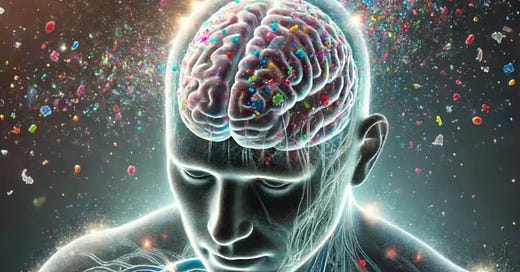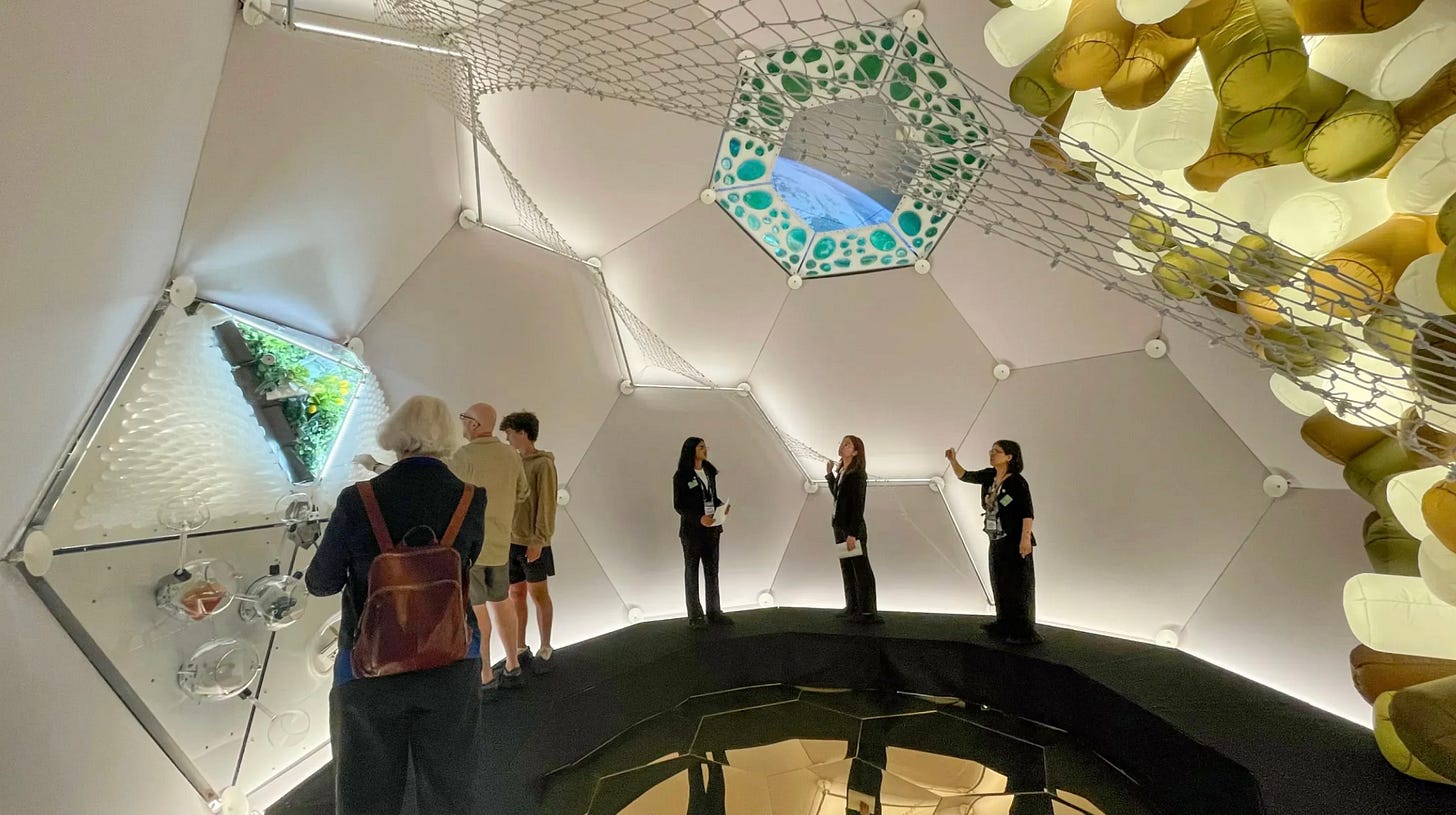This week we investigate a new list of actions that we can take to try and avoid Alzheimer's. Genetics plays a big part in contracting this disease however there are things that we can do that may reduce the chance of catching Alzheimer's. We also catch up with our story from last week about Microplastics. A study from the US sheds light on just how much plastic is now in our brains. The bad news is that the amount of plastic in our brains appears to increasing rapidly. We discover a new air conditioner that can act as a battery. Finally we examine a new design for a self assembling space habitat.
Avoiding Alzheimer’s
The medical journal, The Lancet, has published a list of 14 modifiable conditions that we can all take action on, that appear to have a connection to Alzheimer's Disease. Two new conditions were added to the list this year. The conditions are:
A good education: this includes study in your youth but also cognitively stimulating activities in midlife to protect cognition (i.e. never give up learning, it is part of the reason that I write this newsletter)
Hearing loss: firstly avoid harmful noise exposure and take action to improve your hearing if this becomes an issue.
Depression: get treatment if this becomes an issue.
Helmet use: head protection is important, particularly for bicycles and for contact sports.
Exercise: people who participate in sport and exercise are less likely to develop dementia.
Don’t smoke: this includes vaping, just don’t do it. If you need to smoke to reduce anxiety or due to boredom, get that condition looked at.
Prevent Hypertension: systolic blood pressure of 130mm Hg or less from age 40. Get your blood pressure checked regularly.
High LDL Cholesterol: treat high levels of low density lipoprotein cholesterol from midlife. This condition was recently added to the list as the impact of cholesterol on arteries i.e. hardening and blocking, appears to also have an impact on the development of Alzheimer's
Weight: maintain a healthy weight and avoid obesity. This also helps to avoid diabetes.
Alcohol: avoid excessive alcohol consumption. There is a lot of debate about what level is excessive. We could all probably cut down a bit. Seek medical advice if you are concerned.
Treat vision loss: this condition was also recently added as it appears that vision loss, which can lead to a reduction in activity, is linked to contracting Alzheimer's.
Air pollution: reduce exposure to air pollution where possible. This is difficult in cities. Spend some regular time in nature as much as possible.
This list is a guide only. You should seek medical advice for any concern. It is also a good list for staying active in life. Here is a link to the full article. It is free but you will have to register. Also remember that dementia is complex and there are also many genetic issues involved that we still do not understand well.
Microplastic update
Last week we talked about the conversion of microplastics into graphene. Microplastics are very common in the environment and researchers have found a shocking amount have ended up in our brains.
A team of researchers from the University of New Mexico and elsewhere have compared autopsy results from 2016 and 2024 to understand the impact of the growing amount of microplastics in the environment. The team tested for the presence of 12 polymers in a range of organs. The presence of the polymers was higher in all organs in 2024 than in 2016.
All 92 brains sampled in 2024 contained microplastics. The samples contained 10 to 20 times more microplastics than the corresponding liver and kidney concentrations. 24 of the brains measured an average of 0.5% plastic by weight. That is one part in 200 of the brains were waste plastic. This can’t be good for us.
Researchers have also found microplastics in testicles, penises, semen, arteries, hearts, lungs and bone marrow. We don’t know exactly how microplastics affect our health however studies have linked the presence of microplastics with fertility issues, disrupted immune systems, impaired memory and the growing wave of cancer in younger people.
Some of the samples examined were from people who had died with Alzheimer's. These brains contained up to 10 times more plastic by weight than other brains. The rise in microplastics in the sampled brains is consistent with the rise of microplastics in the environment.
It is probably past time for us to do something about this.
Air Conditioners as a Battery
Blue Frontier a Florida based startup is developing a new type of air conditioner that uses desiccants to cool air. Desiccants suck up moisture in a similar way to the packets of silica beads we use to keep our wardrobes dry. Rather than silica packs the company uses a concentrated salt solution.
The cooling unit passes a stream of air over a thin layer of the desiccant which pulls moisture out of the air. That dry air is then used in an evaporative cooling process, the same process that cools our skin with sweat. This type of system is more efficient than traditional vapor compression air conditioners. The system also has the advantage in being able to charge up at times of low energy demand and cool at times of high energy demand.
Cooling currently uses about 20% of global electricity demand and over 50% of demand in peak hours on hot days in some parts of the world. New cooling technologies that incorporate some type of energy storage can charge themselves when renewable electricity is available and demand is low and still provide cooling services when the electricity grid is stressed.
Blue Frontier achieves this by using a heat pump to evaporate some of the water in the desiccants during periods when cooling is not required. The heat pump can be run constantly or at times when electricity is cheap. This allows the system to be available for cooling when required.
Blue Frontier claims an up to 90% reduction in annual electricity use in commercial applications. There is no condenser so the system is perfectly quiet and the system has up to 6 hours of embedded energy storage. Systems are currently being tested with customers and mass manufacturing is expected soon. Commercial buildings are the initial focus however homes and other buildings are on their road map.
Self Assembling Space Habitat
The International Space Station can only accommodate 11 people at a time. More and more people are traveling to space and assembling habitats in space is difficult and dangerous. Additionally structural components such as walls have to fit onto rockets meaning that it usually takes multiple launches to take everything required to space.
Aurelia Institue, a non profit space architecture R&D lab based in Massachusetts has demonstrated their mock up of a space habitat called TESSERAE. The structure looks like a one story tall soccer ball.
The structure makes the components as compact as possible for launch. The tiles stack like a flat packed IKEA box (it has to be an automated assembly as it is impossible to use an Allen key with a spacesuit gloves on).
Following launch the tiles would be thrown into space in a balloon like structure or net to stop them floating away. Strong magnets on the edges of each tile would then snap the tiles together in the correct configuration. A combination of sensors and magnetometers can determine if they don’t correctly assemble. In the case of wrong assembly a current pulses through the magnets to break apart the incorrectly configured tiles and the system tries again. Following assembly of the structure electrical and plumbing systems are mounted by hand.
Several much smaller test systems have already been assembled successfully in space several times. It is not known if the system of magnets and sensors is enough to assemble the full habitat in space. A propulsion system may be required. Additionally the current structures are not airtight. An airtight interior skin of some sort may need to be added to the interior. The tiles would remain as an exoskeleton.
Aurelia is one of several companies trying to develop the next generation of space habitat.
Paying it Forward
If you have a start-up or know of a start-up that has a product ready for market please let me know. I would be happy to have a look and feature the startup in this newsletter. Also if any startups need introductions please get in touch and I will help where I can.
If you have any questions or comments please comment below.
I would also appreciate it if you could forward this newsletter to anyone that you think might be interested.
Till next week.






Its the microplastics!. Thats why I can't understand some of these technical articles..